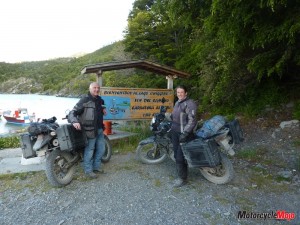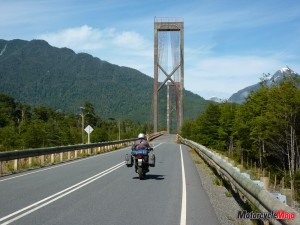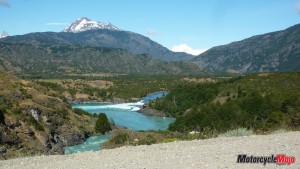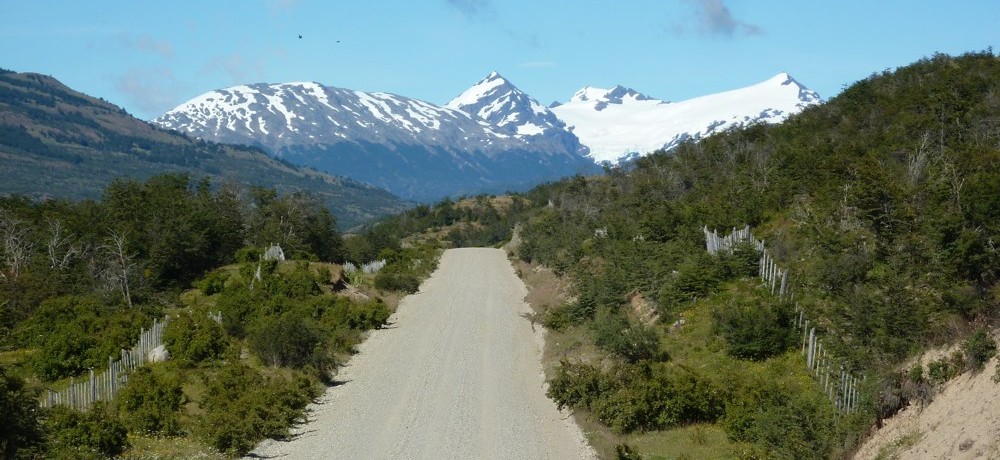A Second Chance in Chile
There’s a road in southern Chile that winds its way along the west coast of the Andes, deep into Chilean Patagonia, past forests, glaciers and snow-capped mountains
before ending in Villa O’Higgins at the southern ice field.
The building of the road, the Carretera Austral (“Southern Highway”), began on the orders of Dictator/General/President Augusto Pinochet in the 1970s. Its purpose was to connect the farthest reaches of the sparsely populated region and help enforce the constantly disputed border with Argentina. It was finally completed in 1999.
By “completed,” I mean it’s 1200 km of loose gravel, sand and soil with some sections linked by ferries. This surface wears down over time from use and weather, causing ruts, washboards and potholes. Underneath the loose surface is a properly engineered road with all the various grades – it’s just the pavement that’s missing.
Many overlanders choose to head south on the east side of the Andes through Argentina, on the more famous, wind-blasted Ruta 40, or use the Navimag passenger-cargo ferry to drift through the Chilean fjords sheltered from the South Pacific by the Chilean Archipelagos.
The Last Time Through
 Back in 2011, while on a “Three Americas” transcontinental bike trip with my wife, Jean, we chose the fjords option, as winter was approaching. For the next few years, we often wondered what riding the Carretera Austral (Ruta 7) would have been like.
Back in 2011, while on a “Three Americas” transcontinental bike trip with my wife, Jean, we chose the fjords option, as winter was approaching. For the next few years, we often wondered what riding the Carretera Austral (Ruta 7) would have been like.
Last year, we heard that work had commenced on laying asphalt in preparation for major hydroelectric dam projects. That was the signal; it was time to go before it lost its air of inaccessibility.
We prefer to ride our own bikes, but on this occasion we decided to opt for rentals. Renting the bikes was much easier than I thought it would be. We contacted Ride Chile (ride-chile.com) based in Santiago and owned by Tomas (Chilean) and Mick (Danish), who have a wide range of bikes from 400 cc to 1200 cc. Jean chose a Honda Falcon NX400 while I opted for a Kawasaki KLR 650.
Once we hit the road, I was pleasantly surprised by the 2014 KLR. The seat height was perfect for me, with just my toes touching the ground. The bench-like seat was comfy for 250 km at a time, which was handy, given the NX400’s reserve light would come on at about that distance. The motor, despite the low power, did everything required for blipping out of the city and onto the main drag south. With its 23-litre fuel tank and 480 km range, I would not be worrying about where the next gas station was, unlike Jean, with her lower 380 km range.
The engine on the NX400 was only three horsepower less, at 30, than the KLR’s, and was more than capable of keeping up. It’s also a light bike and much lower. While Jean, at five-foot-six, liked it and was able to balance comfortably with her feet nearly flat, it was much too low for me and would have been uncomfortable to ride any distance.
Ride Chile kitted the bikes out with plastic “Pelican” panniers, a tank bag and rear rack. A few tools and spares (tire levers and sprockets) were supplied, plus a Scottoiler for chain lubrication. After that you’re on your own, although they will supply breakdown coverage while in Chile.
Pan Am Highway
 The direct route down to the Carretera Austral from Santiago is, unfortunately, on Chile’s long, straight main artery, Ruta 5, part of the Pan American Highway. Ruta 5 stretches over 3000 km, from the desert in the north at Peru to the start of the Carretera, with Santiago, Chile, about halfway.
The direct route down to the Carretera Austral from Santiago is, unfortunately, on Chile’s long, straight main artery, Ruta 5, part of the Pan American Highway. Ruta 5 stretches over 3000 km, from the desert in the north at Peru to the start of the Carretera, with Santiago, Chile, about halfway.
To relieve the boredom, we thought it worthwhile to take a detour via the Chilean lakes, around Villarica and skim past some (semi) active volcanos.
The Carretera starts on the bayfront at Puerto Montt. Initially, you can glide along a well-surfaced road with the glassy waters of the Bay of Ancud to your right and tree-covered mountains ahead and to your left. Soon we came upon the first of a series of water crossings at La Arena. This is a regular service of around 30 minutes per crossing, while the next ferry at Hornopirén is only twice daily (in the summer).
It was New Year’s Day when we rode this stretch, and were taking it easy, not knowing when the first section of ripio would start. It was around 15 km after the La Arena ferry that we encountered the Carretera’s true character. I dropped my speed, stopped at the dividing line between asphalt and gravel and waited for Jean. Then we both set out, feeling the gravel and our bikes on the new surface spattered with potholes and loose sections. Our riding techniques had to change; a much looser grip on the bars allowed the front to skip and find its own line, applying the brakes well before corners or preferably not at all.
Happy New Year
 It was just past midday when we rattled into Hornopirén, raising a cloud of dust, past its quiet streets with tin-roofed houses and fish-farm tanks. A single-storey wooden building, with a surprisingly cosmopolitan café, served as the ferry terminal, where we met an Argentinian biker, Pancho, who had also just missed the last boat and was looking for somewhere to stay.
It was just past midday when we rattled into Hornopirén, raising a cloud of dust, past its quiet streets with tin-roofed houses and fish-farm tanks. A single-storey wooden building, with a surprisingly cosmopolitan café, served as the ferry terminal, where we met an Argentinian biker, Pancho, who had also just missed the last boat and was looking for somewhere to stay.
Being a friendly person and fellow biker, he headed off to find some accommodations for the night, then returned to invite us along and show the way.
And that’s how we ended up eating a New Year’s Day family meal in an otherwise closed hostel. The owner’s family was visiting for the start of the summer holidays and we were invited to sit down and share the curanto – a dish of shellfish, meat, potatoes and dumplings cooked in a pot on hot stones buried in a hole in the ground.
Despite being in Chile for nearly a week, we hadn’t had many chances to practice our Spanish, but aided by the local wine, we were able to converse at a basic level and exchange tales. It was only after the meal ended that the daughter started to speak in English. We thanked her for letting us practice our Spanish.
After Hornopirén, the next day was spent getting to the town of Chaitén – only 70 km of ripio to negotiate, but two ferries are required. From Hornopirén, it’s a three-and-a-half-hour cruise on a ship with Greek signage, through fjords and past Pumalin National Park, which featured snow-topped mountains peeking out above steep-sided valleys, backed by blue sky with small, white clouds crowning the peaks.
Once the ship docked, or more correctly, dropped its bow on a concrete slope, every vehicle rushed off to cover the 10 km of ripio to the next ferry. This is a smaller boat and has to make two or three 40-minute runs, so first come, first served. Bikes have an advantage here, being at the front of the boat and ahead of the cars, trucks and buses. As we descended the last kilometre, the road dipped and rose again, and in front of me were 10 other bikes, spread out across the full width of the road, weaving around potholes and ditches and a brown cloud of dust billowing out against the ice-blue sky. What Remains From the second ferry it was more ripio.
By now our pace had picked up, and Pancho was bringing up the rear behind Jean while I bounced from ridge to mound (with the occasional hairy moment as the whole bike went sideways). The road into Chaitén passes through a forest of stumps and stunted trees – all growing back after the 2008 eruption of the Chaitén volcano. The majority of the town was washed away by mudslides and many houses remain buried. The government officially shut down the town, but people persisted with no utilities and the authorities relented. It is now a small community with the basic traveller’s necessities: fuel, food, hostels and a campsite. The route south continues initially on tarmac, but that becomes less frequent, and after a few days, we became experts on good and bad ripio, or when wet, “shitio.” Ultimately, it’s all down to you and how the bike handles that defines the difference between good and bad. Some days, I would speed off into the distance, soaking up the theatre of nature surrounding us, letting the bike find its own way in the looser, sandier sections while Jean dropped behind. At other times, she would be all over my back end pushing me harder.
Constant concentration was needed because of the changing surface, making fatigue a major concern; generally, this was when I would barrel into a bend too fast and find myself off line and heading for some trees. The ripio can get a bit rough in places, especially where roadwork is occurring as workers lay gullies of loose stone before putting asphalt down. The high passes are still a long way from being tended to; hairpin bends and loose gravel with big drops made for many an interesting day. Of particular note is the Queulat Pass, with 17 hairpin bends rising steeply as you twist around them. Eventually, it opens out into a wide glade with waterfalls running off the steep cliff walls, and purple lupines growing among piles of felled lumber. Heavy rains here cause mud- and rockslides that occasionally close the pass to all traffic except bicycles or light motorbikes.
Southern Range
With the ever-changing scenery of lakes, fjords and valley passes, it’s easy to split the route up mentally into sections. One of the most stunning for us was south of Coyhaique, where the road returned to gravel and wound its way up into another mountain range. Here the bends hugged the cliffsides and the wind whipped and swirled from all directions, trying to snatch the motorbikes from the chosen line. Finally, the road peaked and a wide vista opened up; the road dropped sharply into a vast tree-shrouded plain, ringed with brown-tinged mountains, speckled with snow where the peaks touched the broad sky. Quite spectacular. There are relatively few vehicles the farther south you go. Occasionally, there were road-work trucks, but, more importantly, there were gas trucks. Some days we only saw other motorbikes or cyclists. The latter were the real tough mad men and women. We saw them all along the route, occasionally whole families with young children in “tagalongs,” all heading south with the prevailing wind behind them.
Some had been on the road for years, others just doing the same as us, but only able to progress at 50 to 100 km a day. They measured their trip in months, not weeks. The mix of motorbikes was more varied than we imagined it would be. We saw the usual BMW 1200s, but among the more obscure were two Indian motorbikes. For me, the Chilean on his first bike trip riding his Ducati Hyperstrada was the most surprising. The small town of Villa O’Higgins is only 100 km from the final ferry crossing. This stretch only opened in 2000, which was 24 years after the road building began. The ferry is free, but only runs three times a day. As we approached the quayside, the ferry had already left.
Settling down for a three-hour wait, we were relieved when the ferry turned and the bow doors started to drop. The captain came back for us. We don’t know whether we were just lucky or Villa O’Higgins is always so pleasant. While we were there, it was warm and dry: T-shirt and shorts weather. Sitting on a couch on the verandah of our hostel, drinking beer, watching the sun set over yet another glacier and realizing we had just ridden approximately 2400 km over some pretty dreadful terrain, we had a definite sense of “job done” – and then remembered we still had to get back to Santiago. Sidebar It’s possible to carry on south from Villa O’Higgins to Argentina, but that’s for walkers and cyclists, as there is only a small boat and an animal track to be negotiated, where even cyclists have to carry their bikes over sections. Jean and I retraced our tire tracks north, back to turquoise Lago General Carrera, the second-largest lake in South America, and then to Chile Chico before entering Argentina.
Originally, we were going to ride the Argentinian Ruta 40 north to Bariloche and Mendoza before crossing the Andes and re-entering Chile. However, we encountered our biggest obstacle of the trip as soon as we crossed the border – lack of money. None of our bank cards would work in the bank at the small border town, so we resorted to the black market to exchange the few U.S. dollars we always carry. I wish we had brought more. Three days later we were in the Welsh community town of Trevelin, still without functioning cards and gas stations taking only cash.
We decided to spend the last of our money on a Welsh afternoon tea and Argentinian steak before returning to Chile, where our cards did function and, thanks to a good exchange rate, we felt like millionaires. Doubling back over the Andes, we rode through the gloriously picturesque Futaleufú Valley and back through Chaitén. Not wanting to rush, we had allowed ourselves four weeks for the bike hire, but with good planning and slightly longer days in the saddle, three weeks would be plenty for a relaxed, full Ruta 7 trip. The major cost, after bike hire, is getting there.































